The history of Britain is one of constant migration, in and out, and the recent ‘refugee crisis’ is not a new concept. But where are these stories reflected in People’s History Museum’s (PHM) main galleries?
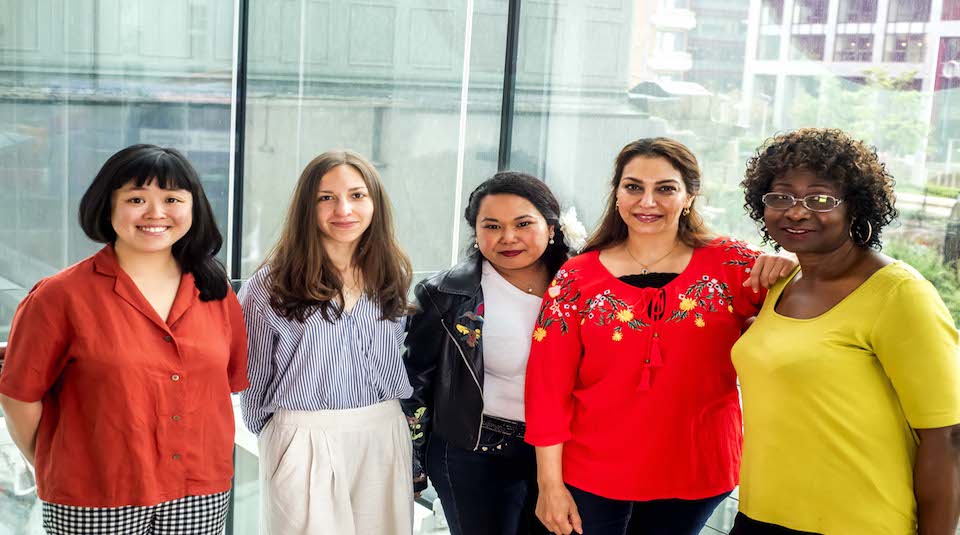
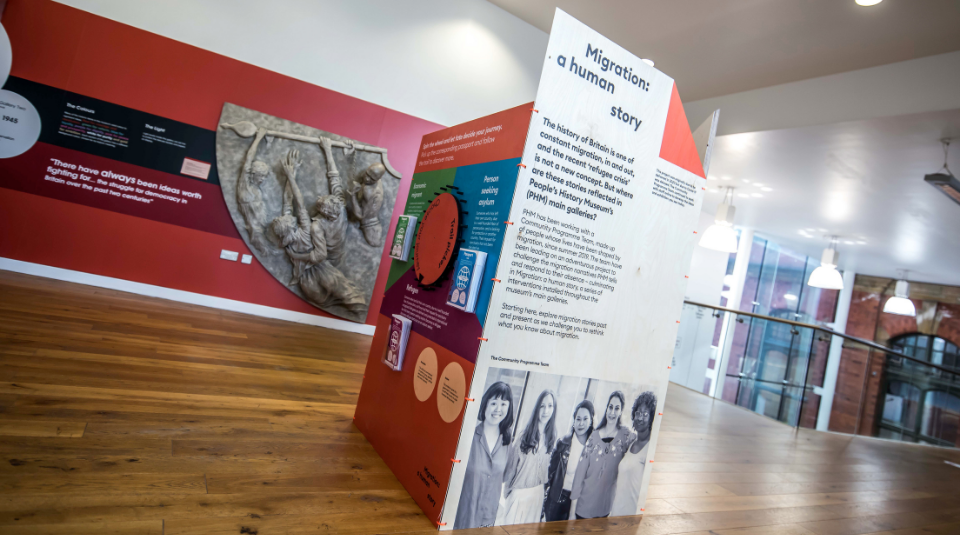
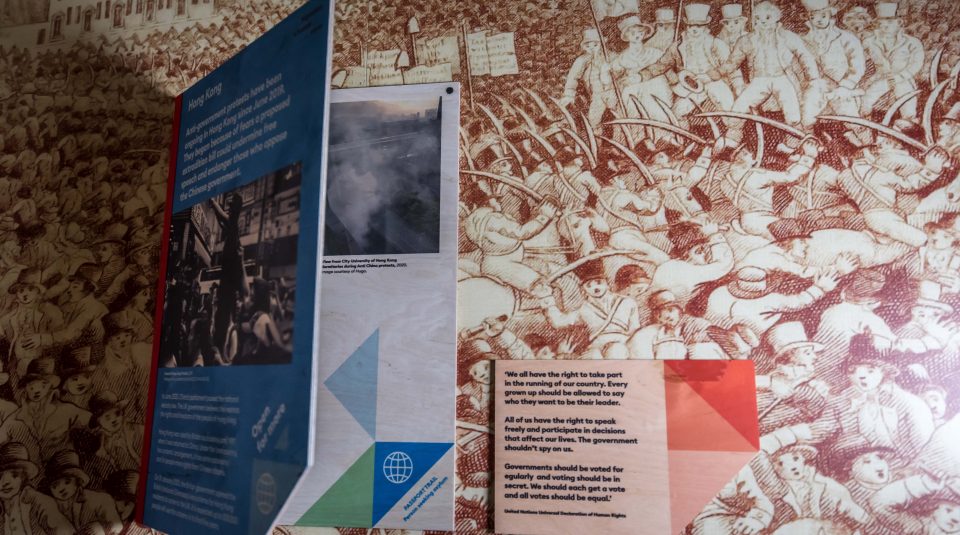
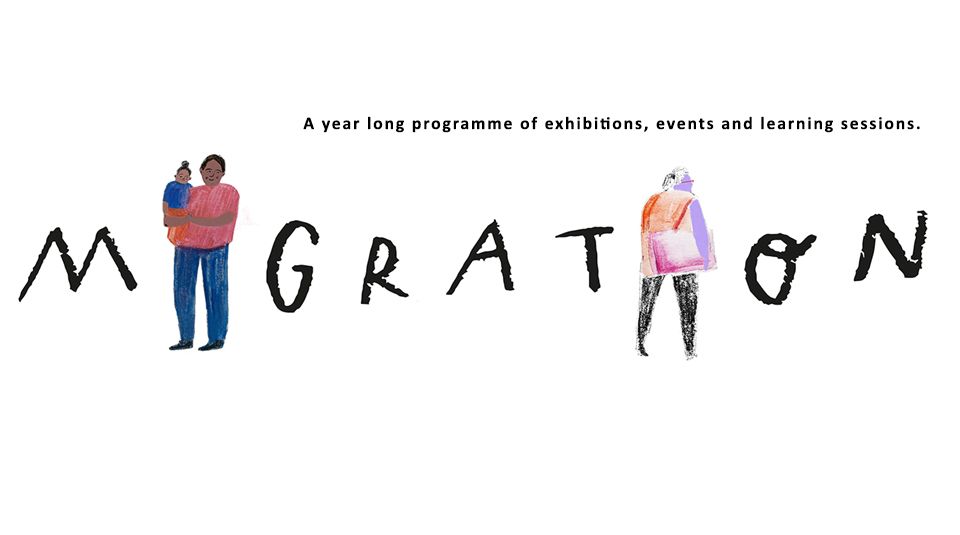
Discover from Katy, Zofia, Monika and Danielle how the migration programme began.
Migration: a human story is the culmination of a project spanning 2019 to 2022. It takes you on an immersive journey that asks you to rethink what you know about migration through a series of creative interventions installed throughout PHM’s main galleries that have been designed in collaboration with a Community Programme Team. These include new interpretation, a newly commissioned banner, a series of animations and challenges to PHM’s Battle for the Ballot.
With support from Art Fund and The Joseph Rowntree Charitable Trust.
Meet the Community Programme Team and explore each of the elements below.
Agnes, Einas, Jo, Monika and Muliana were recruited to co-create PHM’s migration programme. Each has their own experiences of migration and had their lives shaped by its impact.
Between them, the Team has lived in eight countries and can speak 12 different languages.
Meet them below.
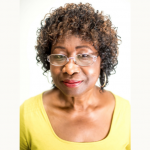
I am Agnes and I come from Ghana.
My husband was invited to work in the UK and after he had settled, he invited me over. My first experience of winter in 1972 was traumatic. I trained and worked as a nurse, spending 36 years in the NHS before retiring as a Divisional Manager. I got involved in PHM’s project to learn more about migration, develop new skills in museum activities and meet new people.
I have enjoyed working as part of the Community Programme Team and appreciate the support from our project co-ordinators and the museum staff as a whole.
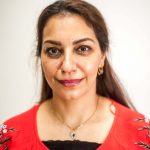
I’m Einas Khaleel, a 45 year old Iraqi dentist who came to the UK on a spouse visa.
It was my choice to move to the UK and leave behind my wonderful life, but it turned out to be the worst choice. I was a victim of domestic violence and divorced only months after moving to Manchester in November 2014.
PHM’s Community Programme Team serves as a window for me to explain and demonstrate to others why we prefer to stay rather than return; how many women in my situation are unable to return because divorce is a stigma in our culture.
I work as a volunteer, interpreter, teacher with supplementary schools, and session worker with Safety4Sisters.
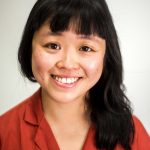
My parents came to the UK from Hong Kong in the 1980s and I grew up in a multicultural household that switched between Cantonese and English in the same breath.
Though I feel a strong pull towards my parents’ heritage, the impact of my family’s migration has created ripples of complexity in the way I navigate my dual British and Chinese identity.
As a frequent visitor of PHM, I was immediately attracted to take part in its Migration programme; meet with and hear from others with diverse experiences of migration; and explore the fascinating connections between migration and the UK’s political and democratic history.
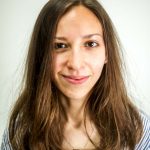
I have been a migrant all my life. Born to Russian-Latvian parents but growing up between the US, Latvia and the UK, I have never really belonged to my family’s cultures or the cultures I have lived in. I am too uprooted to know where ‘home’ is.
It was in Manchester that I realised just how many of us migrants there are. I no longer felt alone in that experience and wanted to share it. Our trials and tribulations are rarely heard and appreciated on an individual level, and they deserve to be. This project presented the perfect opportunity to highlight that.
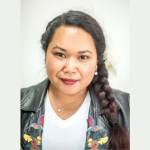
Manchester has been my home for almost 19 years. I love its people, its culture, its historical towns, and the whole vibes of this city.
My husband was born in this city and so are my children.
This city and its community has accepted me as one of their own. I want to give something back to this city; either my time, my knowledge, my skills or my experience. Being part of PHM’s Community Programme Team is the best way to do it.
Migration is part of our life. And we all have different stories of why we migrate.
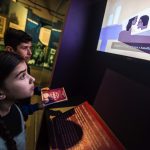
Take a virtual tour of Migration: a human story with Agnes and Einas.
Journey through the new interpretation, including the series of animations exploring the differing reasons people come to the UK, and a banner challenging us to consider why the contribution migrants make to the UK has been so often overlooked and undervalued.
Watch here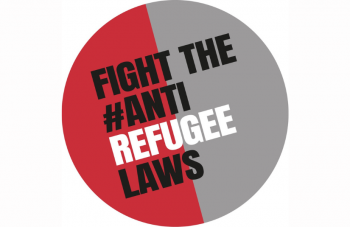
In early 2019, PHM held a period of consultation for the migration programme. We asked individuals and communities what stories needed to be told and what the aims of the programme should be.
PHM was challenged to become an activist museum as part of the programme, and asked to campaign for social justice whilst encouraging visitors to action. People wanted to see a real impact for sharing their stories with the museum. Find out more about the fight we’ve joined against #AntiRefugeeLaws.
Find out moreInterpretation is the term used for the narration that accompanies and explains the objects on display in the museum’s main galleries. As part of the consultation on this project PHM was questioned about its representation of migration throughout the main galleries and the complete absence of contemporary migration experiences.
The Community Programme Team has worked to add new interpretation within the galleries to highlight to visitors historical and contemporary migration stories that are filled with personal insights. Three different experiences of migration are explored, which can be picked out by colour-coded panels. These look at:
An economic migrant
A person who travels from one country or area to another in order to improve their standard of living.
A person seeking asylum
Someone who has left their own country, due to a well founded fear of persecution, and is looking for protection in another country. Their request for sanctuary has not been decided on.
A refugee
Someone who has fled their own country, due to a well founded fear of persecution, and have had their request for sanctuary recognised. Refugees are defined and protected in international law. Not every person seeking asylum becomes a refugee, but every refugee starts out as an asylum seeker.
The newly commissioned work is now a permanent feature with PHM’s galleries. You can explore these different experiences through a Family Friendly Passport Trail whilst you are at the museum.
The Community Programme Team worked with artist Seleena Laverne Daye to create a new banner that would take its place alongside the vast collection of contemporary and historic banners in PHM’s collection.
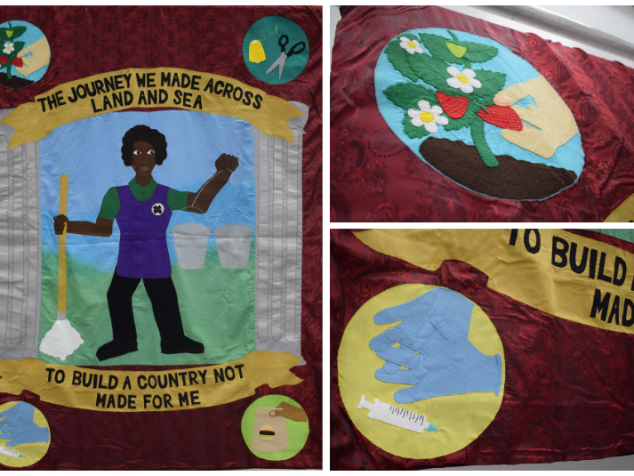

‘This fake trade union banner subverts the white Britishness and classical ideals traditionally upheld by other banners in PHM’s collection.
Instead of the singularly white, British male worker who saves the day, we wanted a more representative banner that gives migrant workers their due and criticises industries for exploiting vulnerable, marginalised groups.
With a medallion in each corner – symbolising agriculture, textiles, healthcare and hospitality – the banner seeks to empower fellow migrants whose hard work and cheap labour remain unrecognised. Many of us are forced to put up with low pay, long hours, little to no representation and no stability because of our backgrounds.
A female cleaner stands proudly in the centre, bucket and mop in hand. A retake on the classical figure of Justice, she highlights the absurdity of the past and the present. From textile factories in Leicester to Uber delivery drivers, this banner celebrates those whose voices are not heard.’
Monika Titane
Community Programme Team
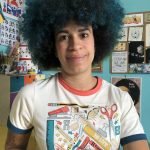
Seleena’s statement
‘In more recent years within my art practice I’ve wanted to create more banners. I’ve always had a fondness for banners, the craftsmanship involved, what they stand for, how they can be used. A way to share one’s voice and be heard.
One half of my family came to England from Jamaica in the 1950s and 1960s, so migration has always been present in my life. I was born in England but am visibly still not ‘from here’.
To get the opportunity to create a banner, to use my skills to create a space and give a voice to those often spoken about or not heard at all, was something I couldn’t pass on. I hope I’ve helped my family and others just like them to TAKE UP SPACE!
The aim of the banner was to create a voice for migrant workers, to share their story and to take up space. Working alongside the Community Programme Team, we wanted to represent as many migrant workers as possible; from those working in the care sector to those working in hospitality, and from agriculture to the textile industry. Workers who are often undervalued and mistreated.
The slogan on the banner ‘The Journey We Made Across Land and Sea, To Build a Country Not Made for Me’ speaks about the hostility migrants face when coming to the UK the narrative told in mainstream media and the poor treatment, not just as workers, but as people’.
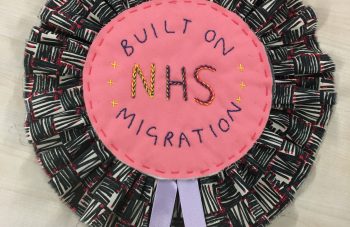
The Fabric of Protest is a monthly creative workshop inspired by the museum’s collections.
Participants create and share textile responses to the topics explored, using techniques taught by artist Helen Mather.
The Community Programme Team commissioned four animations to explore the differing reasons why people migrate. They tell the individual stories of people they interviewed in February and March 2021. By highlighting the complexities of people’s experiences the aim is to challenge the stereotypes of those who come to the UK, to create empathy and understanding.
The animations were produced by Hungry Sandwich Club.
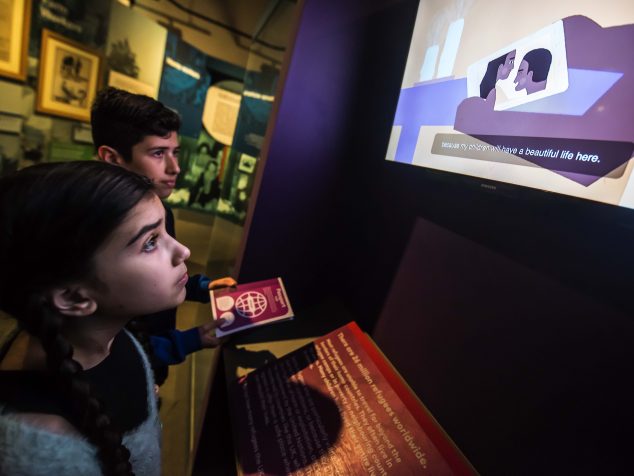

‘One of the goals of the migration programme is to change people’s behaviour and attitudes towards migration.
I thought that animations would be a good way to present what’s behind migrant’s decisions to move, and to show our stories in a way that can be accepted and attractive to different audiences. I found it an opportunity to change behaviour towards migrants and explain the reality and causes of migration, what the difficulties and challenges are before and after coming to the UK. We are not here to take your job, your benefits and taxes, we are partners and can contribute and build the country together for all our prosperities.’
Einas Khaleel
Community Programme Team
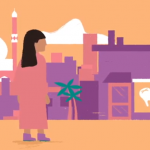
Find out more about some of the lived experiences of people who have migrated to the UK; what it means, what it promises, the difficulties, the risks, memories and realities.
This animation contains descriptions of traumatic migration experiences including domestic violence and religious and political persecution.
Watch here
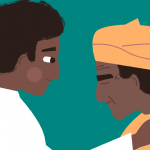
This animation contains lived experience of modern slavery.
Slavery is not a historical issue, it continues today. It takes many forms and affects people of all ages, genders and races.
Slavery is the severe exploitation of other people for personal or commercial gain. People can become entrapped making our clothes, picking crops, working in factories, or working in houses as cooks, cleaners or nannies.
In 2019, the top four nationalities of slavery victims identified in the UK were British, Albanian, Vietnamese and Indian.
With thanks to Hope for Justice.
Watch here
This animation contains lived experience of living in a refugee camp and the resettlement process.
There are 26 million refugees worldwide.
Most refugees are unable to travel far beyond the borders of their home countries. They often live in refugee camps or in poverty in neighbouring countries for years. Many children have lived their entire lives in camps.
Some refugees who are particularly vulnerable due to health condition, or because they are at a high risk of harm or exploitation, are selected for resettlement by the United Nations. They are transferred to countries like the UK, which have agreed to offer them a safe place where they can rebuild their lives.
The UK is home to 1% of the 26 million refugees who are displaced across the world.
Watch here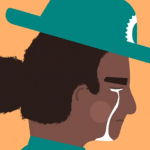
This animation contains lived experience of seeking asylum in the UK on the basis of sexuality.
There are 70 countries where it is illegal to be LGBT+. Over 1,500 people seek asylum in the UK each year on sexuality grounds and face particular hardship and hostility within the asylum process.
Currently, a person seeking asylum has to convince the Home Office they are in danger if they return home by submitting documents and written evidence, before being interviewed by a case worker who decides if their account is believable.
Four in ten people seeking asylum on the basis of sexuality report being rejected because the decision makers did not consider that they were persecuted, or at risk of persecution in their home country.
Watch hereDuring consultation for the migration programme, PHM was challenged on its representation of the history of wars, empire, trade and slavery on the vast mind map Battle for the Ballot displayed on the wall in the atrium of the museum.
The mind map was designed to underpin the redevelopment of PHM’s main galleries in 2010, but many visitors and staff are offended by the way it reduces these complex histories.
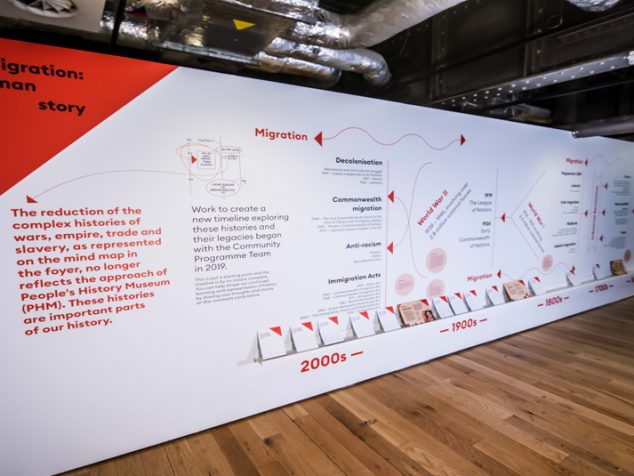

‘Colonies of the British Empire made huge and selfless sacrifices to their sustainability from the inception of the Empire in the 1500s. With this in mind, I was surprised to note that this crucial fact was in a tiny box of four words, with no links to other events on the Battle for the Ballot timeline on display.’
Agnes Fough, Community Programme Team
Work to create a new timeline exploring these histories and their legacies began with the Community Programme Team in 2019. This wars, trade, slavery and the British Empire timeline was displayed at PHM throughout 2021 and 2022 where visitors added their thoughts and stories on comment cards.
PHM has also explored migration through an extensive programme of events and exhibitions.
Suitable for a range of ages, and many of the events are available to watch again on the museum's YouTube channel.
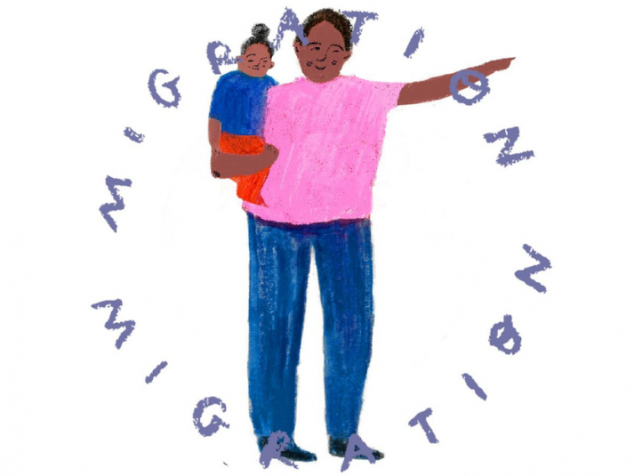
In early 2019, PHM held a period of consultation ahead of the migration programme of activity. We asked individuals and communities what stories needed to be told and what the aims of the progamme should be.
PHM was challenged on its representation of migration throughout the main galleries and the complete absence of contemporary migration experiences.
This is where Migration: a human story was born.
Read our series of migration blogs looking at the Immigration Act of 1971 and how it continues to form the basis of the UK’s immigration laws today, what modern slavery is and the work by Hope for Justice to end modern slavery and an insight into the hidden world of domestic work.
Watch the film about the Voice of Domestic Workers project and other events from the migration programme on the museum’s YouTube channel.
PHM commissioned a virtual LGBT+ history tour focusing on the themes of race, migration and empire from refugee rights campaigners Prossy Kakooza and Maggy Moyo, and PHM Community Curator Jenny White. Watch a full recording of the Migration, Race & Empire: LGBT+ histories tour, on the museum’s YouTube channel.
Read Jenny’s blog A British export that has defined LGBT+ history, past and present, as she introduces a selection of items from the museum’s galleries and collection that featured in the tour.